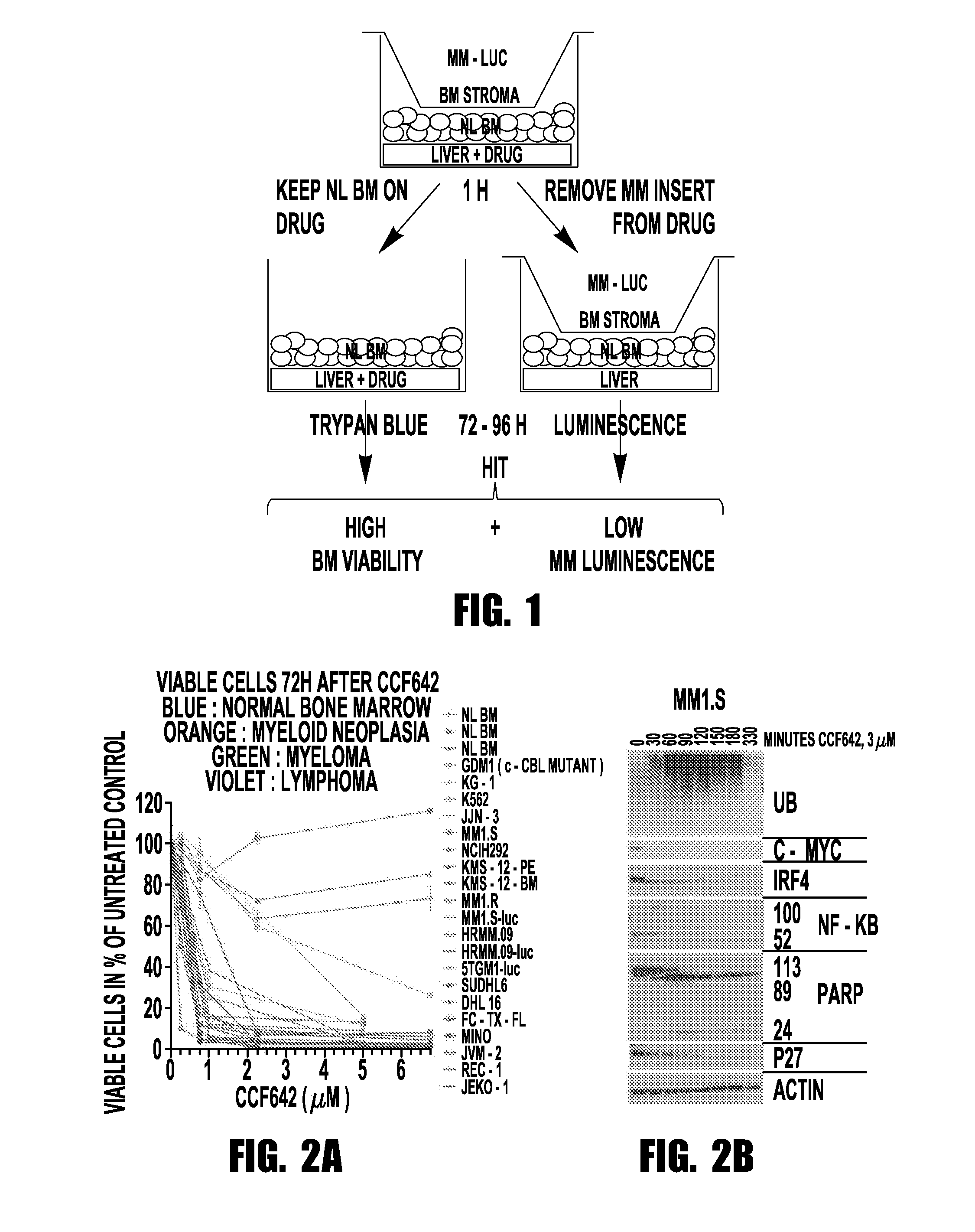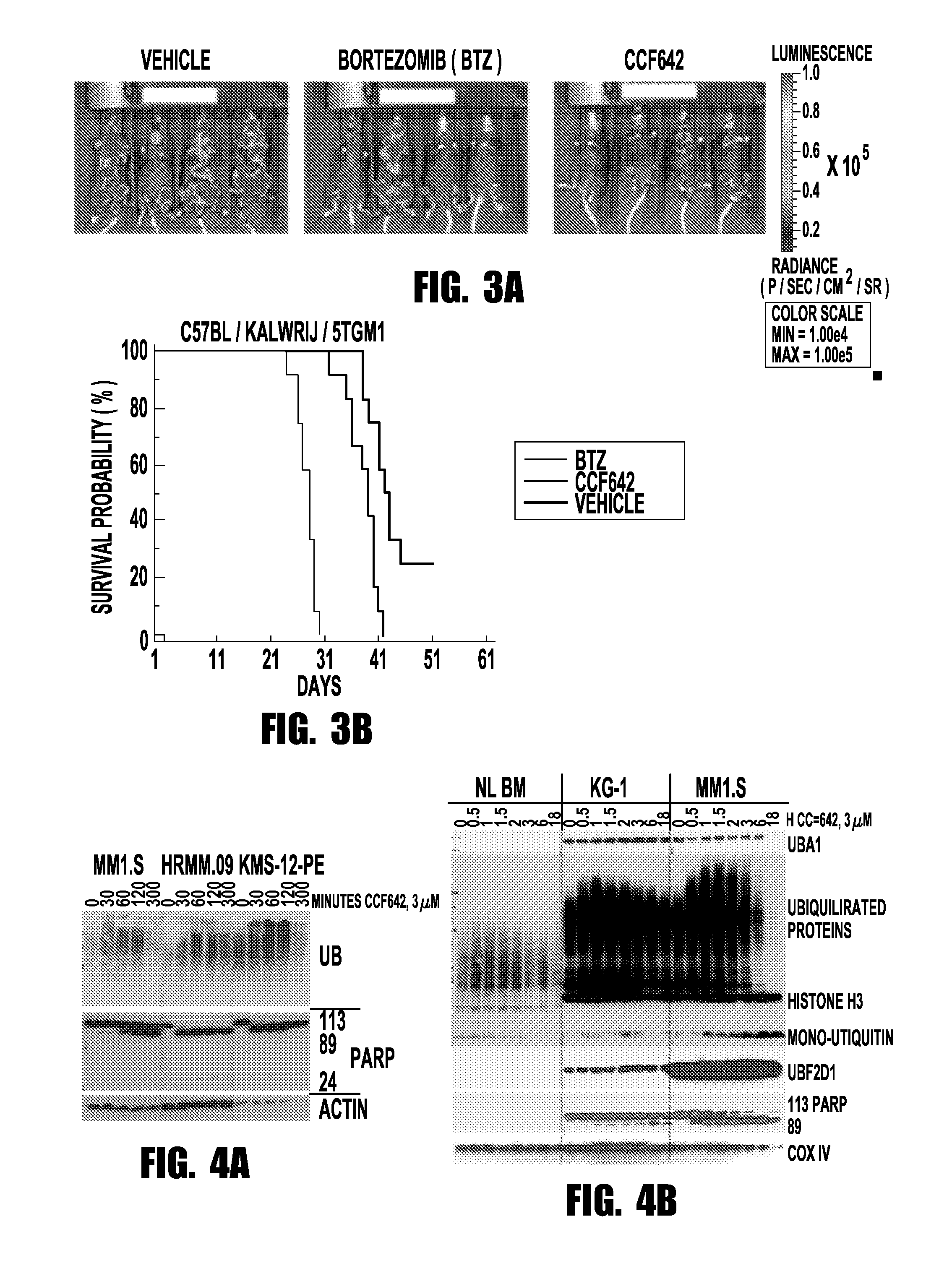Protein disulfide isomerase inhibiting anticancer agents
a technology of isomerase and anticancer agent, which is applied in the direction of biocide, organic chemistry, drug composition, etc., can solve the problems of not yielding pdi inhibitors that entered the clinic, not expected to be curative, and limiting adaptive escape mechanisms, so as to achieve favorable pharmacokinetic activity, confirm tolerability and promise
- Summary
- Abstract
- Description
- Claims
- Application Information
AI Technical Summary
Benefits of technology
Problems solved by technology
Method used
Image
Examples
example 1
Initial Discovery and Evaluation of CCF642
[0066]Taking a mechanistically unbiased approach to drug discovery the inventors developed a sandwich assay that selected anti-MM compounds from a primary ATP-based screen for lack of toxicity on normal bone marrow, stability towards liver enzymes, and activity in the context of cell barriers, bone marrow stromal support, and short, kidney-clearance-like exposure (FIG. 1). CCF642 emerged as the most promising compound and in screening immunoblots after overnight incubation of MM1.S myeloma cells appeared interesting to pursue since in contrast to BTZ it depleted ubiquitinated proteins but within the few hours ubiquitination increased and c-MYC, IRF4, and NF-κB components disappeared (FIG. 2B). In all MM cell lines tested, the IC50 for CCF642 was below 1 μM (˜0.5 μM) but not reached with doses up to 6.75 μM in three independent normal bone marrow samples (FIG. 2A). After the in vivo activity was observed in a systemic syngeneic mouse MM model...
example 2
A Novel Three Organ System In Vitro Assay Identifies New Protein Disulfide Isomerase Inhibitor with In Vivo Activity Against Myeloma
Methods:
[0067]Cell lines: Multiple myeloma cell lines MM1.S, MM1.R, NCI-H929 were obtained from ATCC. MM cell lines KMS-12-PE and KMS-12-BM were from the JCRB, JJN-3 from DSMZ, and 5TGM1-luc cells were from Dr. Yoneda at the University of Texas Health Science at San Antonio. HRMM.09 cells were generated in the inventor's lab from a patient who developed refractory myeloma after treatment with steroids, IMiD, proteasome inhibitors, DNA alkylators, and anthracyclines. MM1.S-luc and HRMM.09-luc were generated in the inventor's laboratory by transduction with Cignal™ firefly luciferase control lentivirus obtained from Qiagen™. Lymphoma cells were generated by Mitchell Smith. All MM and lymphoma cells were grown in RPMI 1640 (NaCl 103.45 mM, NaCO3 23.81 mM, Na2HPO4 5.63 mM, KCl 5.33 mM, Ca(NO3)2 4H2O 0.424 mM, MgSO4 0.407 mM, pH around 7.2), supplemented wit...
PUM
| Property | Measurement | Unit |
|---|---|---|
| structure | aaaaa | aaaaa |
| affinity | aaaaa | aaaaa |
| plasticity | aaaaa | aaaaa |
Abstract
Description
Claims
Application Information
 Login to View More
Login to View More - R&D Engineer
- R&D Manager
- IP Professional
- Industry Leading Data Capabilities
- Powerful AI technology
- Patent DNA Extraction
Browse by: Latest US Patents, China's latest patents, Technical Efficacy Thesaurus, Application Domain, Technology Topic, Popular Technical Reports.
© 2024 PatSnap. All rights reserved.Legal|Privacy policy|Modern Slavery Act Transparency Statement|Sitemap|About US| Contact US: help@patsnap.com










